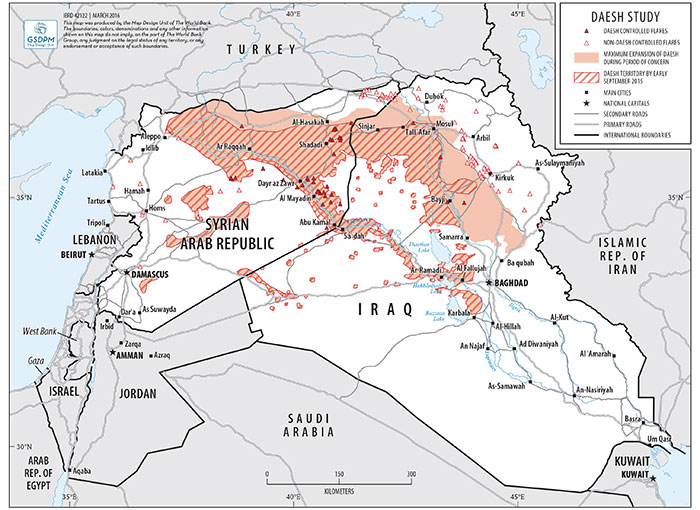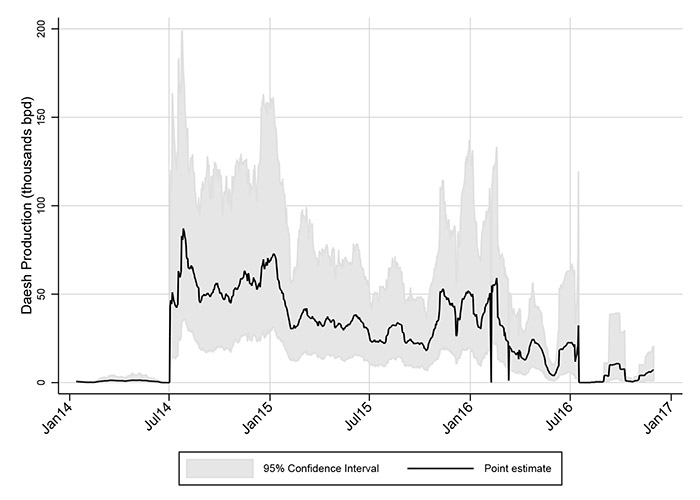Oil production by the Islamic State of Iraq and Syria (ISIS) steadily declined between 2014 and 2016, indicating that the group was financing itself in other ways, like taxation or extortion.
Using satellite imagery, a team of researchers led by Princeton University and the World Bank analyzed 42 oil production sites controlled by ISIS across Syria and Iraq. The researchers found the group’s production peaked in 2014, but never came close to pre-war production and declined steadily through 2016, long before the group lost physical control of its oil assets.

Because many terrorist organizations and insurgencies tap oil as a revenue source, it is important to accurately measure production. The study, released Nov. 1 by the World Bank, is particularly compelling, as it provides a real-time census of production by evaluating all sites in real time. Previous estimates rely on opportunistic evidence from a few production sites at different times, or places where journalists had a source or intelligence agencies captured documents.
“Assessing oil production is critical for making sound economic policy and doing so in contested areas can enable governments and international organizations to identify illegal or untaxed production as well as assessing the impact of policy changes,” said co-author Jacob N. Shapiro, professor of politics and international affairs at Princeton’s Woodrow Wilson School of Public and International Affairs.
In addition to Shapiro, the research team included lead author Quy-Toan Do, World Bank; Christopher D. Elvidge, National Oceanic and Atmospheric Administration (NOAA); Mohamed Abdel-Jelil, the World Bank; David P. Ahn, Johns Hopkins University and the U.S. Department of State; Kimberly Baugh, University of Colorado; Jamie Hansen-Lewis, Brown University; and Mikhail Zhizhin, University of Colorado.
When crude oil is extracted, natural gas is released, primarily in the form of methane. This gas is typically collected and disposed of by flaring, which produces radiant heat and can be used as a predictor of the volume of oil extracted.
Using satellite multispectral imaging, the researchers looked at the radiant heat produced by gas flaring at production sites, a common method of natural gas disposal across Syria, Iraq and most the world. They accounted for production sites that produced oil with natural gas flaring, sites that produced oil without natural gas flaring (and used venting instead), as well as inactive production sites.
They combined these calculations with ground-truth, pre-war data to effectively construct a real-time, day-to-day census of oil production.
The results show that production levels were approximately 56,000 barrels per day from July to December 2014. Production dropped to an average of 35,000 barrels per day throughout 2015, before declining further to approximately 16,000 barrels per day in 2016.
The researchers are cautious to translate their findings into revenue estimates, as oil prices can change dramatically over time. Assuming ISIS could receive $25 per barrel, however, their oil income would have been around $42 million per month in 2014, $26 million per month in 2015 and $12 million in 2016. This is far below many published estimates.
“We can’t be more precise about revenue because we don’t know what prices were in the area,” Shapiro said. “Some say they were way below the world market price because the local economy was cratering, and the black market oil sold out to Turkey was competing with legal sources and thus had to be sold at a discount. Others say there was a captive market with little outside supply in many parts of Syria and Iraq, so ISIS could charge a premium on the world market price. No one really knows, but the $25 per barrel is within the range of reported prices from 2014 to 2016.”
The results are also in line with ground-truth data. One example is the Ajil oil field in the Hawija area southwest of the city of Kirkuk. ISIS took control of this area in 2014 and continued oil production through January 2015. Production stopped until March 2015, when the field was set on fire by the group to counter an attack by Iraqi forces. Fighting in the area continued, slowing production, until it was fully retaken in late 2015. Then, production increased, but only slightly.
The study, which is among the first of its kind, bridges the knowledge gap on economic activity in ISIS-controlled territories and can be built on to inform planning for short-term humanitarian assistance and long-term reconstruction.
“Understanding the structure of the economy in ISIS-controlled areas is important, as it gives us a better idea of the welfare of the local population,” Shapiro said. “Taking stock of the status of the oil infrastructure will help design reconstruction plans and inform post-conflict redistributive policy interventions.”
The paper, “How Much Oil is the Islamic State Group Producing? Evidence from Remote Sensing,” was released Nov. 1 by the World Bank.

